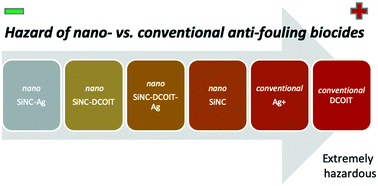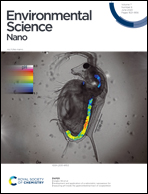Hazard of novel anti-fouling nanomaterials and biocides DCOIT and silver to marine organisms†
Abstract
Biocide-based coatings have been applied for several years to tackle marine biofouling. Recently, engineered nanomaterials, such as silica mesoporous nanocapsules (SiNCs), were used to encapsulate DCOIT, an anti-fouling booster biocide, and Ag, a broad-spectrum bactericidal agent, in order to control their release with time. This study aims to assess the environmental hazard of three novel anti-fouling nanomaterials (SiNC–DCOIT, SiNC–Ag and SiNC–DCOIT–Ag) and their free counterparts (DCOIT, Ag and SiNCs) to marine ecosystems. In order to accomplish this goal, marine toxicity data (L/E/IC50 or NOEC) were compiled to derive PNEC values for each compound based on statistical and deterministic approaches. The first approach relies on the hazardous concentration for 5% of the species (HC5 using species sensitivity distribution curves) and the second relies on the lowest L/E/IC50 or NOEC value, considering the appropriate assessment factors. In both approaches, PNEC values were lower for the encapsulated biocides than for their free forms. Thus, biocide encapsulation appears to be a promising solution to develop a new generation of efficient anti-fouling additives for maritime coatings with lower environmental hazard than the current state-of-the-art biocides.



 Please wait while we load your content...
Please wait while we load your content...